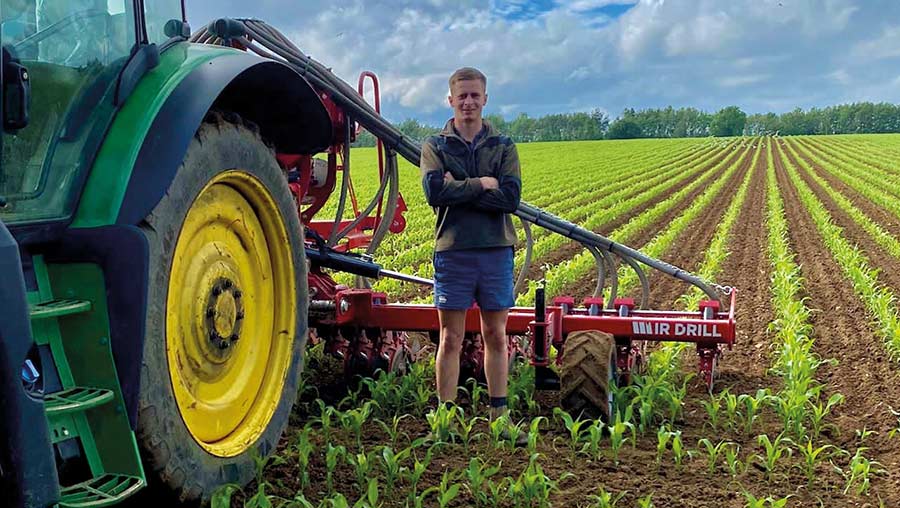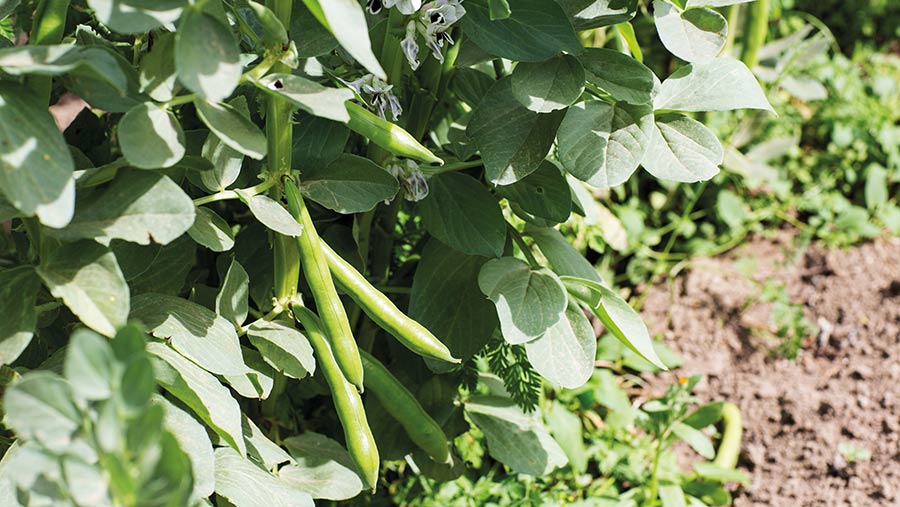Why a Dorset farmer is undersowing maize with field beans
 © West Park Farm
© West Park Farm Dorset dairy farmer James Houghton is planting field beans beneath a crop of maize in a trial which he hopes will boost the protein content of feed and potentially reduce requirements for artificial fertiliser.
After the success of undersowing maize with grass for the first time last season at West Park Farm near Poole, Mr Houghton strove to take this a step further.
As he puts it: “If we could grow grass beneath the maize row, why not grow a protein source?”
See also: Cereals 2022: Biostimulant fixes nitrogen in air into crop form
With the price of fertiliser and concentrate feeds for the dairy on the rise, he thought this would be the perfect opportunity to plant a home-grown protein source as an understorey to help offset the rise in costs.
Farm Facts: West Park Farm, Dorset
- 180ha dairy farm, milking 200 cows supplying local Blackmore Vale Dairy
- The family operates a grass and maize silage contracting business alongside the dairy
- Maize yields average 16t/ha, peaking at 19t/ha last year
- The Houghton family has farmed at West Park Farm for two years, having previously farmed elsewhere in Dorset, Hampshire, Berkshire and Yorkshire
Variety choice
Eager to get the idea under way at the family dairy farm milking 200 cows, Mr Houghton contacted his agronomist Emma Bumby from Green World Chemicals to discuss the right species and variety for the job.
The variety Maris Bead, commonly grown for the pigeon feed trade was selected for its good protein source, energy content and downy mildew resistance (8, on a 1-9 scale, with 9 showing the highest resistance and 1 the lowest).
Beans are relatively slow to emerge and can consequently be susceptible to weed invasion, especially at the seedling stage. With this in mind, a variety which was competitive enough to establish into a standing crop of maize was selected.
What’s more, the variety offers relatively early ripening (5) and grows to a reasonable height (120cm), enabling both crops to be harvested together with the maize chopper header.

© Adobe Stock
Bean establishment
A 35ha area of beans were planted into a standing crop of maize on 7 June, just before the maize had reached the four-leaf stage.
The beans were undersown into three equally spaced rows using a Weaving inter-row drill between the 75cm maize spacings.
A seed rate of 28.5kg/ha was used, planting the beans into moisture at about 5cm deep.
Mr Houghton previously planted the grass crop beneath the maize at the four-leaf stage but due to the more sensitive nature of beans, he decided to plant them slightly earlier.
This would achieve a longer establishment window, leaving time for the beans to mature in sync with the maize.
A total of 120kg N/ha is applied to maize crops and if the trial proves successful there may be scope to reduce future nitrogen rates due to the N-fixing powers of the beans.
However, one drawback of undersowing with beans is the absence of available chemistry for weed control, placing a huge importance on cultural control methods.
Thankfully, last year’s grass crop established well with good ground cover that prevented weeds from emerging.
Mr Houghton hopes the beans will follow suit, but as the crop is slower to establish and the canopy takes longer to close, there is concern weeds may take hold.
Maris Bead’s PGRO Descriptive List vital stats |
|
| Trait | Maris Bead |
| Earliness of maturity* | 5 |
| Straw length (cm) | 121 |
| Standing ability at harvest* | 7 |
| Downy mildew resistance* | 8 |
| *=on a scale 1-9, with 9 exhibiting that characteristic the most | |
Maize establishment
In total, 52ha of the maize variety P3726 was planted across the farm’s sandy clay loam soils of which 16ha is undersown with grass and a further 14ha with beans.
Maize drilling commenced on 19 April, planted into moisture at about 6cm deep with crops looking well with sufficient rain to get crops established.
Traditionally established using a plough and power harrow, this year marks the first time crops have been drilled using a Kuhn Striger strip-till.
“One-third of crops were planted using the strip-till drill which has saved us a significant 3.5 litres/ha of fuel, down from 8 litres/ha with the plough and power harrow.
“Not only does this save fuel, but it also reduces labour costs and means we’re doing our bit for the environment,” he says.
The family also plans to trial undersowing grass into strip-tilled fields this season.
Undersowing with grass
Last year, Mr Houghton took the plunge to undersow a 16ha field of maize with four different grass species in a trial assessing the impact of this on soil erosion and nitrogen leaching.
Working alongside Wessex Water, four different grass species were trialled in individual 4ha plots, consisting of Italian ryegrass, cocksfoot, meadow fescue and festulolium (a natural hybrid of ryegrass and fescue species which combines the stress-resistant genes of fescue with the bulky yield of ryegrass).
Three rows of grass at 12.5kg/ha were planted no earlier than the four-leaf stage.
This was the earliest they could successfully introduce the grass without it growing away too vigorously and swamping the sensitive maize crop.
This also left sufficient time for any herbicide residues present in the soil to no longer pose a risk to grass establishment.
From the trial, Italian ryegrass was noted as the variety of choice, producing the greatest yield, quality and quantity of grass with the best ground cover and was most cost effective.
The festulolium on the other hand struggled to establish, which was suspected to be due to its increased sensitivity to chemical residues within the soil.
“Overall, the whole process was really positive. The grass travelled significantly better at harvest, with no wheelings from tractors and there were no yield penalties.
“After harvest we topped the stubble and the grass really took off and tillered well. We even managed to take a 4t/acre (10t/ha) cut of silage in April.”
Payments available
Wessex Water offers growers within the Poole harbour catchment sensitive area a payment of £83.50/ha to cover the cost of undersowing maize with grass to reduce nitrate leaching and improve water quality in the area.
The company calculates undersowing prevents 55kg/ha of N from leaching, the equivalent of £1.52 for every kg of nitrogen saved.
However, it is worth noting that no payment is available for undersowing maize with beans or other crops.
Despite this, Mr Houghton hopes the benefits of this home-grown protein will outweigh any potential costs associated with establishing the crop.

